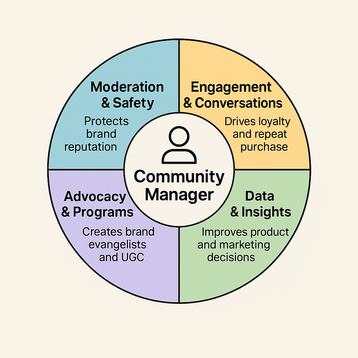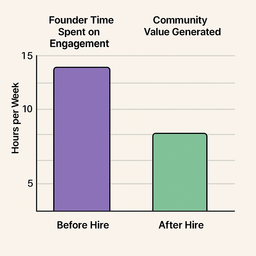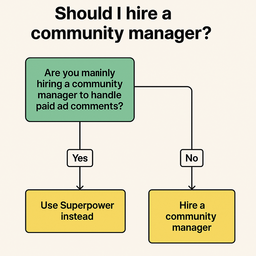December 4, 2025
A data-backed breakdown of the real comment patterns driving ad performance in 2025.
Aug 22, 2025
10 Min
Should I hire a community manager? Learn when ecommerce founders should hire, when to wait, and how tools like Superpower can handle ad comments efficiently.

As an ecommerce founder, you’ve likely considered every growth lever—from paid ads to influencer collaborations. But have you ever asked yourself: should I hire a community manager? In an era where customer trust and brand authenticity reign supreme, building a vibrant online community isn't just “nice to have”—it can be game-changing.
In this article, we’ll explore whether hiring a community manager makes sense for your ecommerce brand. We'll unpack what the role truly entails, how to gauge the right time to hire, and what to do if you're mainly looking to manage paid ad comments (hint: using Superpower might be a smart, cost-effective alternative). You’ll also get practical advice on writing the perfect job description, interviewing top candidates, and setting the role up for success.
By the end, you’ll have a clear roadmap—tailored to ecommerce contexts—on how a community manager can shift shoppers into loyal advocates and whether the investment aligns with your growth stage.
Most ecommerce businesses start with one-off transactions. Someone sees an ad, clicks, and buys. But the real winners in ecommerce aren’t just those making sales—they’re those turning customers into communities.
A community transforms your relationship from transactional to relational. Instead of chasing one-time sales, you’re cultivating repeat buyers who evangelize your brand. Glossier built its empire this way—leveraging fan communities before it ever had a traditional marketing budget.
For an ecommerce brand, a strong community means:
Consider this: acquiring a new customer is 5–7x more expensive than retaining an existing one. Community management is essentially retention marketing. By giving customers a space to engage, ask questions, and connect, you’re keeping them invested emotionally, not just financially.
Trust also compounds. When people see real humans engaging with your brand—whether through replies, user-generated content, or community recognition—they’re more likely to stick around. In a world where ecommerce options are endless, trust and connection are your competitive moat.
A community manager isn’t just someone who replies to a few comments on Instagram. The role is much broader:

Modern community managers go beyond moderation. They act as:
According to the Community Roundtable, successful community managers often wear budgeting hats too—allocating resources, selecting platforms, and advocating internally for community ROI. For founders, this means you’re hiring someone who doesn’t just “chat with customers” but someone who helps convert conversations into revenue.
Ask yourself: why do I want a community manager? If your only answer is “because other brands have one,” pause. You need clarity.
Without a “why,” you risk wasting resources.
If you (the founder) are already spending more than 5–10 hours per week engaging with comments, moderating discussions, or fielding DMs, it’s a signal you may need help. Your time is finite—and at some point, engagement work starts eating into growth, partnerships, and strategy.

Hiring a full-time community manager costs money. Salaries range from $50,000–$80,000+ depending on experience. For early-stage brands, this may feel steep.
But the opportunity cost of not investing can be higher: negative comments left unanswered on ads, poor customer experience, or missed retention opportunities. A simple framework: if your lost revenue from poor engagement exceeds 1–2x a manager’s salary, it’s time.
Unlike ad spend, community ROI isn’t immediate. But it is measurable. Metrics include:
If you’re tracking these and see community engagement correlating with better business outcomes, you’re primed for a hire.
Not every brand needs a full-time community manager right away. Many start with a pilot community phase:
If engagement stays high, a dedicated manager can amplify it.
A rule of thumb: if you’re seeing dozens of new comments, posts, or inquiries daily across your social and ad platforms, you’ve reached a point where unmanaged engagement risks brand damage. At this stage, outsourcing or hiring part-time quickly transitions into a full-time need.
But what if you’re early? What if most of your “community” today is just people leaving comments on your paid ads?
This is where tools like Superpower shine. Instead of paying a full salary, you can automate moderation, categorize sentiment, and even auto-reply within brand guidelines. For founders still testing product-market fit, Superpower is a leaner way to stay on top of engagement without committing to a full-time role.
Superpower is designed specifically for brands dealing with paid ad comments at scale. It helps ecommerce founders:
Instead of a human sifting through hundreds of “is this a scam?” comments, Superpower ensures your ads stay conversion-friendly—improving ROAS and reducing wasted spend.
If your goal is simply “keep ads clean, protect ROAS”, Superpower is enough. But if you want to build relationships, host conversations, and create rituals, you’ll eventually outgrow automation. Think of Superpower as a first step—perfect for scrappy teams not yet ready for a full-time hire.

Some of the best community managers are already in your orbit—superfans, engaged customers, or even employees in adjacent roles (support, social media). They already “speak your brand.”
Externally, look for candidates with experience in ecommerce communities or high-growth startups. Agencies and job boards like CMXHub or LinkedIn are good starting points.
There’s a trade-off:
Ideally, find someone with both.
Your JD should tie directly to your “why.” For example:
Bonus: mention budget management or event planning if relevant to your community roadmap.
Ask candidates to draft a 90-day plan: what they’d prioritize, what metrics they’d measure, and how they’d report success. Alternatively, simulate a crisis scenario and observe their tone and judgment.
Set clear, achievable goals within the first 90 days:
Equip them with tools: CRM integration, Superpower (for ad comments), analytics dashboards. Measure:
As your community matures, your lone manager may need help. Typical scale paths:
The role evolves from tactical (comment moderation) to strategic (program creation, budget advocacy). Mature brands often have Directors of Community leading full teams.
Deciding should I hire a community manager isn’t just about filling a new role—it’s about investing in a strategic asset that amplifies brand loyalty, customer trust, and sustainable growth. For ecommerce founders juggling countless priorities, it's crucial to ask: do you have a clear vision for what your community should achieve? If the answer is yes and you're seeing increasing engagement, feedback, or questions pouring in, then hiring a community manager can not only lighten your load but actually elevate your brand.
That said, if you're primarily looking to manage high volumes of paid ad comments—without yet needing the full breadth of community strategy—automated tools like Superpower can efficiently bridge the gap. It handles volume, speeds responses, and gives you breathing room to assess the community's real potential before making a salary commitment.
If you do hire, remember to start with clarity: articulate goals, write a role aligned with your brand, assess for both empathy and analytical ability, and track early wins. And as your community grows, don’t be afraid to expand into moderator roles, ambassadors, or even a small internal team.
Ultimately, the right moment to hire is when the value of deeper customer connection outweighs the cost—and when you’re ready to foster a community, not just manage comments. You've laid the foundation; the right person can help it flourish.
1. When should I hire a community manager for my ecommerce brand?
Once your brand sees sustained engagement (especially comments, questions, feedback), and you feel stretched, it’s time—typically during or after a pilot launch.
2. Can I just use tools instead of hiring someone?
Yes—tools like Superpower can handle ad comment volume efficiently, but they can’t replace brand tone, empathy, or community-building strategy.
3. What’s the difference between a social media manager and a community manager?
Social media managers create and post content; community managers moderate, engage, build relationships, and foster long-term loyalty.
4. How much does an ecommerce community manager cost?
Salaries vary by region and expertise, but it's critical to factor in impact—many successful founders find the ROI through engagement, retention, and advocacy outweighs the cost.
5. What metrics should I track after hiring a community manager?
Track response time, sentiment (positive vs negative), repeat customer rate, engagement levels, and community-driven referrals or UGC.

Explore expert tips, industry trends, and actionable strategies to help you grow, and succeed. Stay informed with our latest updates.